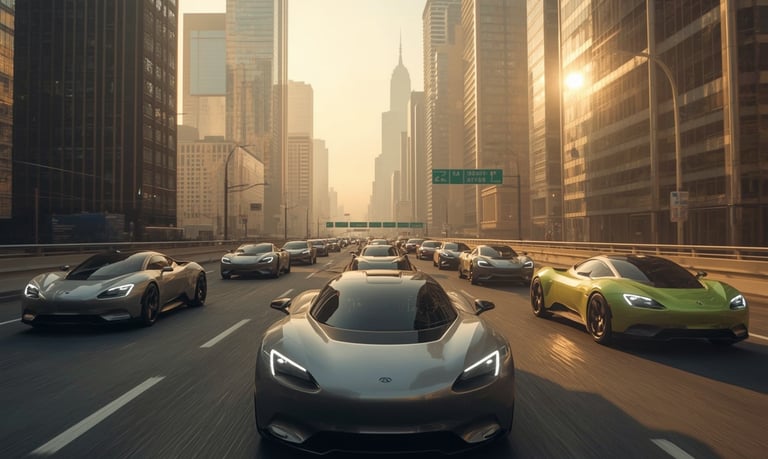Electric Vehicle Revolution: Why the Future of Cars is Clean, Smart & Sustainable
AUTOMOBILE


The electric vehicle revolution is here — driven by rising fuel prices, climate change urgency, and government incentives. From fast-charging infrastructure to long-range EV batteries, innovation is making EVs more practical and affordable. By 2030, nearly half of all new cars sold will be electric, reshaping the automotive industry and driving sustainability forward.
What’s Driving the EV Craze? The Rise of Electric Vehicles and the Road Ahead
The global automobile industry is going through its most significant transformation in over a century. At the center of it all lies the electric vehicle (EV) revolution, a movement that has grown from niche innovation to mainstream adoption at record pace. What once seemed like hype is now an undeniable reality. By 2030, nearly 1 in 2 new cars sold worldwide could be electric, according to global market forecasts.
So, what’s fueling this massive shift? And why are automakers, governments, and consumers all leaning into electric vehicles as the future of mobility?
This blog explores the forces driving the EV craze, the hottest innovations, challenges that remain, and what the future holds for electric cars.
Why Electric Vehicles Are Becoming Mainstream
The surge in electric car adoption is not random — several global factors are accelerating this transformation.
1. Rising Fuel Prices and Cost Savings
Rising fuel prices have made traditional internal combustion engine (ICE) cars expensive to maintain. Consumers are now seeking eco-friendly and cost-effective driving alternatives. Charging an EV often costs far less than filling a petrol or diesel tank, especially when powered by renewable energy.
2. Climate Change Urgency
Transportation accounts for more than 25% of global carbon emissions. As governments and industries face immense pressure to decarbonize, zero tailpipe emission vehicles have become essential for fighting climate change and improving air quality.
3. Government Subsidies and Policy Push
From India’s FAME-II scheme to U.S. tax credits and the European Union’s strict emission standards, policymakers are aggressively encouraging adoption. Subsidies, rebates, and tax incentives are making EVs competitive with traditional cars, boosting consumer interest.
What’s Hot in the EV World Right Now?
The EV industry isn’t just about sustainability — it’s also about performance, technology, and convenience. Here are a few exciting developments:
1. High-Performance EVs
Modern electric cars are breaking records in acceleration and speed. For instance:
Tesla Model S Plaid achieves 0–100 km/h in under 2 seconds.
Rimac Nevera is regarded as one of the fastest production EVs.
Mainstream automakers like Hyundai, BYD, and Volkswagen are also offering performance-focused EVs that rival premium cars.
.
2. Range Anxiety? Not Anymore
The days when electric vehicles could only travel 150–200 km per charge are behind us. Many current EVs exceed 500+ km per charge, and innovations like solid-state batteries promise even greater driving ranges.
Examples:
Lucid Air: ~800 km per charge
Mercedes-Benz EQXX prototype: over 1,000 km per charge
3. Smarter EV Charging
Instead of slow home charging sessions, the world is upgrading to fast-charging networks that get EVs powered in 15–20 minutes. In China and some parts of Europe, battery swap stations have emerged, allowing drivers to replace depleted batteries with charged ones in just minutes.
4. EV Ecosystems and Smart Connectivity
EVs today are smart mobility devices. Dedicated apps let users lock or unlock vehicles remotely, monitor battery health, schedule service, or find charging stations. Features like bi-directional charging even allow EVs to supply backup energy to homes during outages, transforming them into mobile energy hubs.
Why Electric Vehicles Matter Beyond Technology
The rise of EVs is not just about speed or innovation. They represent a shift toward sustainable living and cleaner cities.
Zero Emissions: EVs help lower air pollution levels in busy urban centers.
Lower Noise Pollution: Electric vehicles reduce road noise, contributing to calmer environments.
Energy Security: By using renewable energy for charging, countries can cut dependence on oil imports.
Climate Goals: Large-scale EV adoption is critical to global net-zero emission targets.
The Roadblocks to EV Adoption
While the shift is rapid, challenges still exist for electric vehicles:
1. Charging Infrastructure Needs Expansion
In many developing economies, the EV charging network is still at an early stage. Drivers often fear being stranded on long-distance trips. Massive investments in charging stations and fast-charging technologies are key to solving this.
2. High Upfront Costs
Although operating costs are lower, many EVs are still priced higher than fuel-based cars due to battery production costs. While government subsidies reduce the gap, affordability remains a hurdle for middle-income buyers.
3. Battery Production and Environmental Concerns
The production of lithium-ion batteries comes with environmental and ethical issues, particularly in mining lithium, cobalt, and nickel. Manufacturers are addressing this by investing in battery recycling and more sustainable extraction methods.
What’s Coming Next for Electric Vehicles?
The industry is innovating fast, and the future of electric cars is exciting:
Affordable EVs under $10,000 / ₹10 lakh: Automakers are already working on budget-friendly compact EVs.
Solar-Powered Charging Stations: These will make recharging cleaner and more accessible.
Wireless Charging While Driving: Pilot projects on smart highways show cars charging as they move.
Bi-Directional Charging at Scale: EVs providing electricity back to the grid or powering houses will become commonplace.
Solid-State Batteries: With faster charging and longer life, they will eventually replace today’s lithium-ion packs.
EV Adoption Forecast by 2030: Experts predict that by 2030:
Around 50% of all new cars sold will be electric.
China, the U.S., and Europe will lead adoption, while countries like India will see exponential growth through incentives.
EVs will disrupt not just automotive markets but also the energy, oil, and supply chain industries, creating new ecosystems for jobs and sustainability.
